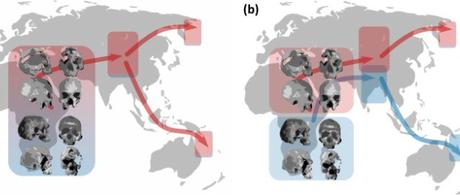
Humans originally evolved in Africa around 200,000 years ago. However, as you may have noticed we didn't stay there forever. It wasn't long before we had spread across the entire world, making us the most wide-ranging primate ever. Suck it, all other monkeys. How, when, and why our ancestors undertook such a massive journey has been at topic that's puzzled palaeoanthropologists for years. And now the situation seems to have got even more puzzling, with the revelation that Aboriginal Australians stem from a unique, earlier migration to all other non-Africans.
In most locations the arriving humans seem to have been part of the same migration. All non-Africans share a bit of Neanderthal DNA. This suggests that this migrating population had a rather kinky encounter with our evolutionary cousins early into their journey. This was then inherited by everyone else. And across Europe and the Middle East the first tools the arriving humans made are almost identical. Again, this suggests that they were all being made by the same migrating population, armed with the same technology and the same culture.
So what's the evidence for this other, hidden migration?
The international team of researchers examined more than 2,000 skulls - including several prehistoric ones - from populations along the migration route. Using a battery of statistical analyses, they examined how closely related these skulls were. These results revealed that Aboriginal Australians and Melenians seem to be part of a unique, isolate population. All the other skulls they examined are similar enough that they could come from the same migration.
Perhaps most interestingly, later populations on the route the early migration took don't show much similarity with them. This suggests that the early migration didn't stick around. Or maybe they were driven out by the later arrivals.
Speaking of later arrivals, how did they identify that the Australian migration was earlier than the other? Well, their data wasn't quite robust enough to provide the exact dates. However, they do note that several "early" stone tools that appear to have been made by modern humans were found along the early route. Yet no actual modern humans were found with them. Personally, I'm always a bit suspicious of identifying specific species from stone tools alone (most of the time).
And of course, that isn't the only issue with this research. How do they reconcile the fact that Australians also have the Neanderthal DNA? That would suggest they belong to the same population movement as the other groups with that DNA. Or maybe not. The researchers note that some groups on this early migration encountered (in the Biblical sense) the Densiovans. These archaic humans might have been the source of their archaic DNA.
And that's really by big complaint with this research: it's trying to infer things about genetics from stuff that isn't genetics. Don't get me wrong, this research is rigorous, interesting and far from untrue. But before we start rewriting the (pre)history books I think we need a tad bit more data.
References
Boyd and Silk, 2012. How Humans Evolved
Reyes-Centeno, H., Hubbe, M., Hanihara, T., Stringer, C., & Harvati, K. (2015). Testing modern human out-of-Africa dispersal models and implications for modern human origins. Journal of human evolution.

